Clear design born from chaos
Shinichi Mitsuhashi
―― First words of new president
In June 1973, we were all waiting in line to meet Tomio Kubo, the second president of Mitsubishi Motors Corporation, when he arrived at the design studio as soon as he assumed office. As he had led the automotive division during his time at Mitsubishi Heavy Industries, we had a feeling that he would be squeezing us hard again.
Kubo’s first words to the designers of the design section were, “From now on, I will make design decisions.” Until then, design decisions had been made by consensus among executives from the planning, development, and sales divisions, but Kubo declared, “Leave the design to me. ” With these words out of the blue, I felt the nerves of everyone in the room, including myself, rally around Kubo. Following this, his pep talk flew. ” First of all, design. Technology takes money and time. Design can be done with wisdom and sense.” “You listen to the sales people too much.” He seemed to be annoyed that the new Galant, which had just been unveiled, was now rounded off. “You do what others can’t do. Creation is the value of human existence,” he continued. This was the beginning of the intense relationship between the new president Kubo and the design section.
―― Design direction
The next day, the design work on the Galant Sigma began with a concerted effort. At the first design review, six renderings were proposed, from which my proposal was selected. My aim with this proposal was to continue and develop the 1st gen. Colt Galant. I wanted to further develop the appeal of the highly acclaimed sporty sedan. While keeping the image of the 1st gen. in mind, I took advantage of the favorable conditions in terms of dimensions to express a sense of stretch and stability in the side view. The semi-fastback design broke away from the box-on-box style that was the norm for sedans at the time. The hexagonal window graphics with the beltline cut out below and the low rear wheel arches and the side lines running in a straight line above the arches to the rear end were all distinctive features of the design.

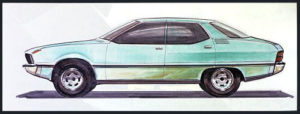
Rendering by writer

Initial fullsize model
Although the design direction was decided, a difficult road awaited us after the transition to the full-size model stage. Since this was an important project, it was necessary to keep a wide range of choices open, so Kubo asked Giorgetto Giugiaro, who at the time was at the top of the world’s car design, to make a design proposal. The model that was sent to Japan was a nicely restrained and elegant design, and its superbly balanced form was a true testament to Giugiaro’s work. However, I guess that Kubo thought that this was too generic for Mitsubishi to make its presence in Japan as a company chasing after Toyota and Nissan, and he decided to stop further requests to Giugiaro.
Meanwhile, we in the design section tried out seven different models one after another, including a six-light model and a notch-back model. However, Kubo’s reaction was not good. Whenever he came to the studio, he cursed us, saying, “Can you only come up with such a lousy idea?” He even kicked models when he was in a bad mood.

Six-light model (left)Notch-back model(right)
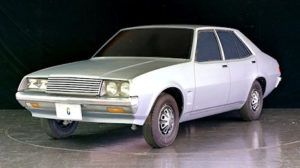 |
Proposal G developed from initial full-size model |
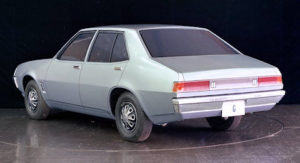 |
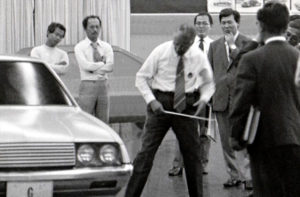
President Kubo point out design with his favorite indicator stick
―― Drastic measure in chaos
Then, in order to get out of this situation, the opinion was raised that we should make a fresh start and try a new approach. The idea was to create an image model in which the basic dimensions were omitted in pursuit of ideal proportions. So, with Ryu Kaibuchi, who had been in charge of the successive model of the initially selected design, at the head of the team, we all set about the drastic measure. The clay was scraped off and a simple image model was created, just to look at the proportions and mass. The lower height of this model created a strong tumblehome and turn-under on the sides of the body, and the whole body was formed as a single mass (later named “monolithic form”), moving away from the concept of three-box or box-on-box. We can say that we returned to the image of the initial sketch, and here it was finally materialized.
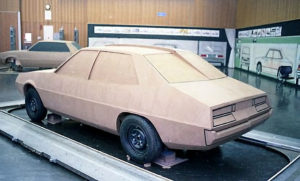
Image model in ideal proportions
One day in April 1974, Kubo came into the studio after a while. Not paying attention to the many models in progress, he spotted the image model in the corner and said, “I like this one. Why don’t we go for this.” he said. With these words, we finally had a glimmer of hope for the future. 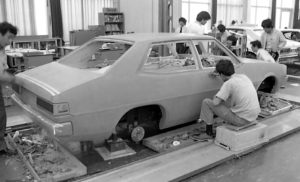
Final-stage clay model with revised basic dimensions and stylish design
―― Trials before goal
After receiving President Kubo’s endorsement for the image model, it was decided to lower the overall height by 25mm to 1360mm. This was the first time in my experience that the basic dimensions had to be revised so drastically in the middle of development, for the sake of styling design. However, this low and wide design worsened the interior comfort, and some people criticized that it looked like a 4-door coupe. Yet, by this time, four-door hardtops were already beginning to appear in Japan, and I felt that the direction of this unrivaled sporty and stylish sedan was the path needed to move ahead of the competition.
After that, the finishing stage was left to a team led by Takio Nakagawa, with Kiyoshi Honda in charge of the front, Matsuo Katayama in charge of the rear, and Nakagawa in charge of the overall design, who worked persistently until the end to catch up with the schedule, which had already been significantly delayed.
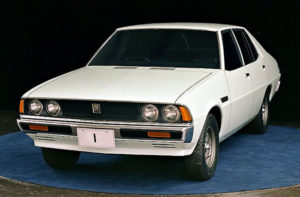 |
Finally approved Proposal I. After this, proceed to detail finishing |
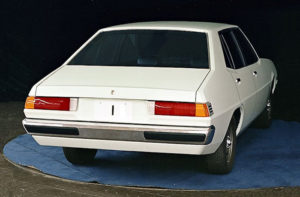 |
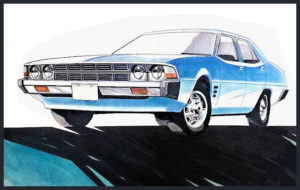
Sketch by Kiyoshi Honda
However, the trouble was that even at the stage of final production preparation, Kubo was not afraid to give detailed orders. He would say, “You know, this part is a bit monotonous. It would be amateurish to finish like this,” and he even tried to scrape off the model himself. One day toward the end of 1974, Kubo was not satisfied with the design of the front corner lamps and ordered us to be redone.
But the time was running out. I had no choice but to ask some of the staff to give up their New Year’s Holidays to work on the project. For the employees, it was a precious holiday to spend with their families. I was grateful that they agreed to give it up, but the difficult part was convincing the union to let them work. The union leaders blasted me with a red face, asking what I was doing making employees work from New Year’s Day. The development schedule was delayed significantly, and the engineering and the production departments that were to follow complained one after another. Even our modelers, who had been cooperating with us, were sarcastic. It was truly a siege.

Team of designers, modelers, and studio engineers shared the hardships. Writer in the center of front row
Thus, I had nothing but severe trials and painful memories of this project, but in May 1976, the car was named “Sigma” and launched with great success. I was particularly pleased that the “Super Saloon,” which was differentiated by its front grille and luxury interior to meet the market’s preference for high-end models, attracted so much attention, as I had not expected it to. The “Sigma,” as the name implies, was a project that brought together all of the company’s resources, and we were very happy to receive compliments from our dealers and competitors, who said that the design was a return to the roots of the 1st gen. Colt Galant.
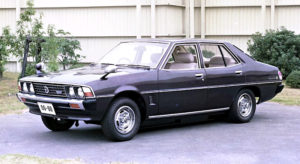
FRP model of Super Saloon integrated interior and exterior
―― Kubo’s words with implication
Finally, I would like to share some excerpts from the words of Kubo, the main character of this development, when interviewed by “CAR GRAPHIC” magazine.
“There is no point in just having a good shape. The styling must be backed up by technology. That’s what makes our technical products unique and interesting. That’s why I go to Okazaki to have a row with the young people there. I would say whatever I wanted, and they would do it well. Even when I think it is impossible to do something, they do it. Well, time is delayed because of all the stuttering. But if the initial design is bad, there will be a worthless car forever, so the beginning is infinitely important. It is OK to be late at first. When the time comes to say, “This is good enough,” I say, ” Let’s do it as it was scheduled in the beginning,” and everyone cries. Even so, everyone works hard. Designing is much more interesting than being a president.”
As this statement shows, he was a man with brightness and a heartwarming gentleness amidst his strictness. He never once praised us and always scolded us, but strangely enough, we could not hate him. We were strongly attracted to his personality and his will to create a good design car. I think it was because we were connected at the basic level of creating something.
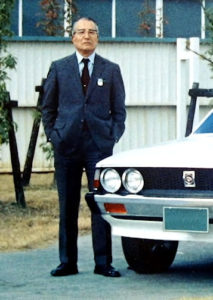
Tomio Kubo and his 1st work as president, Galant Sigma
May 2022
Modern, high-quality Interior
Haruo Okamoto
―― New upscale orientation
In the early 1970s, the domestic market had a full lineup of sedan derivatives, and users began to enjoy themselves with the type of car that suited their lifestyle. In addition, as the number of people who had driven two or three cars increased, users’ eyes began to focus not only on appearance and driving performance, but also on ease of use, convenient functions, and safety measures, and they began to desire a car that was one rank higher. Against this backdrop, development of the Galant Sigma began, targeting the upscale orientation of existing Galant users. Mitsubishi launched the New Galant in 1973, a luxuriously dressed-up version of the 1st gen. Colt Galant, but its reception did not meet our expectations. The result was a reminder to us to change our view of what is required of a luxury-oriented car: comfort, quality, and a sense of security, rather than visual luxury and nostalgic extravagance.
―― First job in Interior Studio
In 1973, our design section underwent a major organizational change, and a new interior studio was formed. The aim was to improve the quality of design by having interior designers gather in one studio to share their various expertise and know-how, and to work across the board on parts that were shared between models. The interior design of the Galant Sigma was the first of such jobs.

Initial rough sketches
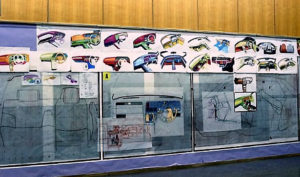
Design study by idea sketches and tape drawings
The exterior design involved considerable trial and error, exploring innovative styles. For the interior design, the shape and tilt angle of the window area, as well as the position and height of the front deck and beltline, were closely related, so we constantly checked how they would be affected by any major changes to the exterior design. On the other hand, the product planning and engineering departments requested that the instrument panel be able to be installed on derivative vehicles (coupes and pickup trucks) without major changes. This meant that more time was needed to verify the visibility and the shape related to operability to satisfy installation in vehicles with large differences in steering angles and eye range positions.
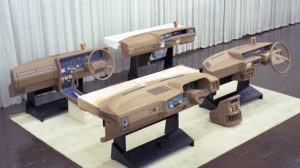
Searching for direction with four clay models
―― ”One-panel meter” born from chat
Since interior design has many items to consider and relationships with various departments, the instrument panel design, which is the most difficult, was slightly advanced. Two proposals were presented: a shelf-type instrument panel with a”one-panel meter” (A design in which several meters appear as one panel) and a center console-integrated instrument panel. The evaluation at the review meeting was split, with no clear winner or loser. In the end, however, the shelf-type instrument panel was selected in accordance with our opinion that it suited the product concept and exterior design of the car. This instrument panel aimed to create a soft, gentle, and open atmosphere, rather than a luxurious one with a distinctive shape.
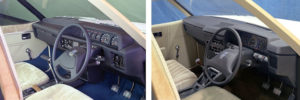
Shelf-type instrument panel (left) center console-integrated instrument panel (right)
The idea for this ”one-panel meter” came about by chance. In the initial sketches, the meter portion was often omitted and painted black to roughly depict the overall shape of the instrument panel for the time being. In the course of chatting over the sketches, some people suggested that such an idea would be good. We decided to consider this as one of the design elements. I thought that other companies might be doing this kind of drawing, so I looked into it and sure enough, there were similar sketches. I thought to myself, “Everyone thinks the same way,” and decided that if we were going to do it, the first one to do it had to win. The meters were made by cutting the top and bottom of the round meter frames, using the inner scale and outer numbers, and using a wide typeface, so that they were large and easy to read without raising the hood too much. In addition, the spacious layout of the gauges has resulted in a very wide, clean, and high-quality design.
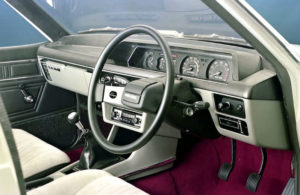
Final approval model
―― Super Saloon that exceeded expectations
The Super Saloon version, added in the latter half of development, was initially developed with a target of 500 units per month. The instrument panel was enhanced with chrome air outlet grilles, smoked non-reflective glass to enhance the one-panel image, Jacquard weave seat fabric, and large door armrests incorporating ashtrays and door lamps. The design was based on a manufacturing method that was suitable for a monthly production volume of 500 units (although the unit price would be higher, the capital investment would be lower). At the time, the production volume of 800 to 1,000 units per month was the borderline for determining the manufacturing method. However, this version received a much more favorable reception than expected after its launch, and we had no choice but to increase production. Since the manufacturing method was originally designed for low-volume production, vendors and purchasing departments had a difficult time dealing with the situation.
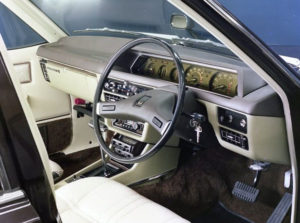
Instrument panel of Super Saloon
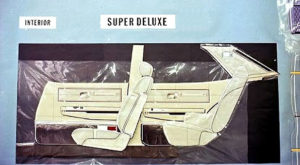
Design study of Super Saloon interior
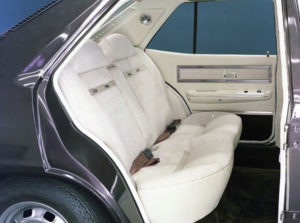
Rear seat of Super Saloon
―― Interior that can be felt by all five senses
The Galant Sigma has been very well received since its launch thanks to various new technologies and mechanisms, including the Silent Shaft for quietness, and especially in terms of design, it has been highly evaluated for its uniqueness and clear image that is different from other competing cars. The interior, which we designed, was also highly acclaimed for its comfortable and open atmosphere with a European style, and we felt that we were able to achieve our initial goal.
I believe that people perceive interiors differently than they do exteriors. Interiors are something that can be felt with all five senses. Not only the shape but also the surface texture, feel, seating comfort, sound and feel when operating the controls, and many other things are conveyed to people as their impressions of the interior. I had been consciously designing interiors to make people feel comfortable without getting tired through the five senses in the small space of a car.
November 2021